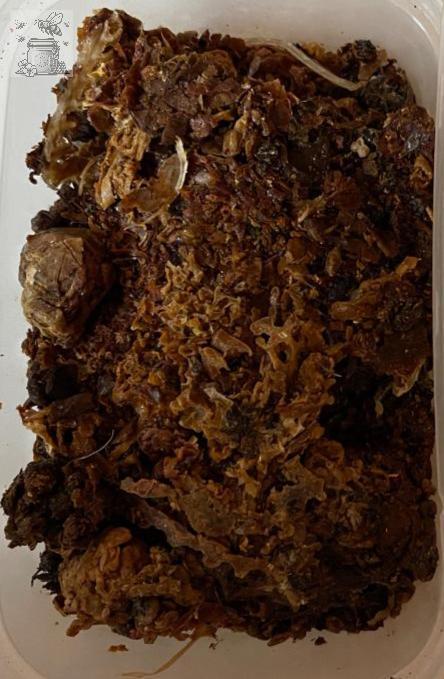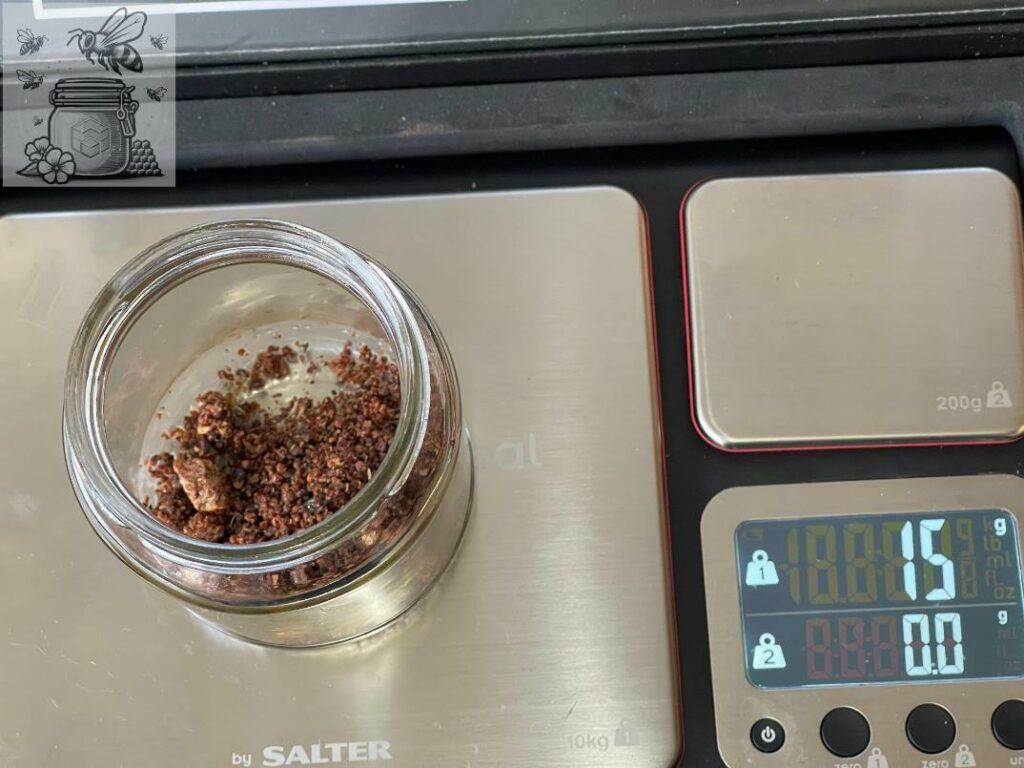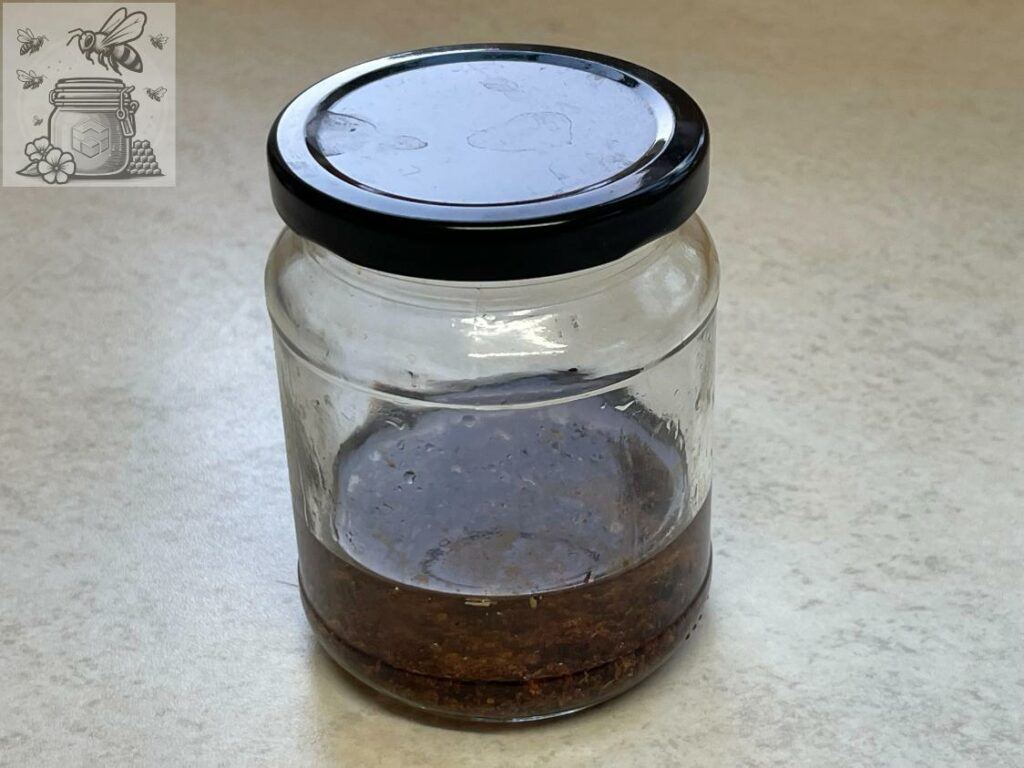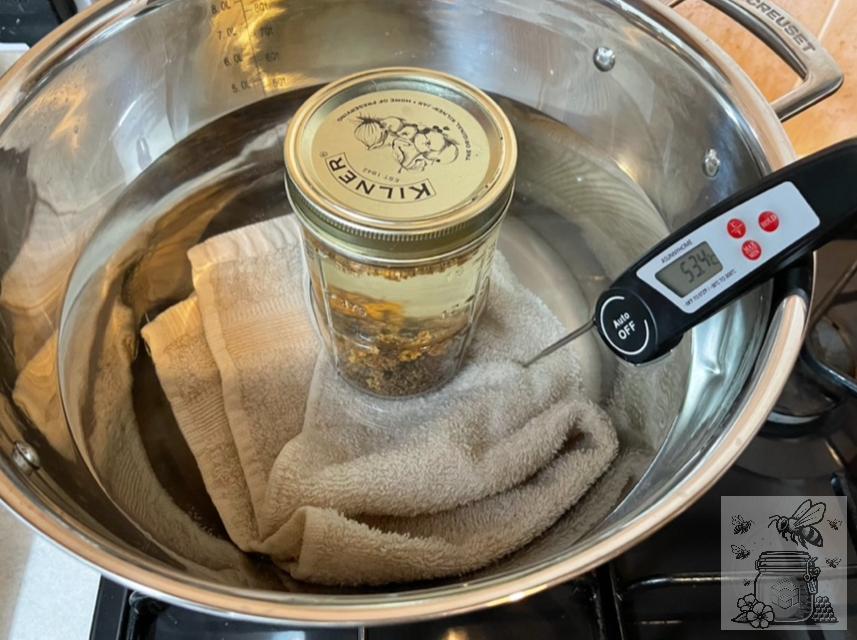Propolis extracts are available in various forms such as tinctures, pastes, ointments, powders, tablets, and capsules. Perhaps the most common extracts are alcohol-based (known as propolis tincture) or water-based.
Propolis tincture and water based extract can be made at home, and it is quite easy. Yet, they are effective and versatile, and can be used not just on their own but in various combinations to create other beneficial products.

If you use raw propolis, it should be cleaned if it is heavily mixed with wax, bee parts, wooden pieces, and other debris, so that you basically end up with propolis resin. Cleaning removes unwanted particles and impurities from propolis that might affect the quality and efficacy of the final product. Starting with clean propolis ensures that the extract or product is as pure and potent as possible.
Propolis Resin vs. Raw Propolis vs. Propolis Extracts
- Propolis Resin is the original material collected by bees. It is a pure form of the sticky substance gathered from plants and mixed with a small amount of beeswax and bee secretions. It has not been altered or purified and retains all the original compounds found in the collected resin.
- Raw Propolis refers to the propolis resin that has been harvested directly from the hive. It includes the resin along with other materials like beeswax, debris from the hive, and sometimes bee parts.
- Propolis Extracts are purified forms of propolis, created by extracting the active compounds from the resin using solvents like ethanol, water, or glycol. Extracts contain concentrated bioactive compounds, making them easier to use in supplements and topical products.
In summary, propolis resin is the raw, sticky substance naturally made by bees, serving as the foundational material for all other forms of propolis. It differs from raw propolis and propolis extracts in its purity and processing levels. While raw propolis is a mix of resin and other hive materials, extracts are refined versions, focusing on bioactive compounds.
Warming: to make propolis resin more pliable, it can be gently warmed (without overheating to preserve its active compounds). This softened resin can then be molded into desired shapes (usually rolls or balls) or used directly.
You can get already cleaned propolis from beekeepers which is ready to use, often in the form of small rolled sticks or balls. Or, if like me you have your own hives and collect propolis while cleaning them, then you will have raw propolis.
Tip: propolis is heavier than water, so if you have some propolis and it floats in water, it contains too many impurities (wax, pieces of wood, dead insects, dust, etc) and should be cleaned .
Once you have got nice and clean propolis, you can make the following products.
I. Alcohol-Based Propolis Extract
Alcohol-based propolis extracts, also known as propolis tinctures, are a potent and effective way to harness the medicinal properties of propolis. The alcohol acts as a solvent, extracting and preserving the bioactive compounds. Here’s a 15 % propolis tincture recipe with a step-by-step guide to making it at home:
Materials and Equipment Needed

- Propolis (cleaned and dried, in pieces) — 15 grams
2. High-Proof Alcohol (ideally between 60 and 70 %) — 85 ml
3. Glass Jar with Lid (preferably amber or dark glass, or an empty jam or honey jar, cleaned and dried)
4. Cheesecloth or Fine Mesh Strainer
5. Dark Glass Dropper Bottles (for storing the extract)
6. Kitchen Hammer (for crushing the propolis into finer pieces)
7. Measuring Cup
Step-by-Step Recipe
Step # 1: Prepare the Propolis
- Freeze the Propolis: place the cleaned propolis in the freezer for at least an hour. Freezing makes it more brittle and easier to crush.
- Crush the Propolis: once frozen, put the propolis pieces in a piece of cheesecloth and crush them into a fine powder using a kitchen hammer. Crushing increases the surface area, allowing for more efficient extraction.
Step # 2: Mix Propolis with Alcohol
- Combine Propolis and Alcohol: place the crushed propolis into a clean glass jar. Pour the high-proof alcohol over the propolis. (For 10 % propolis tincture use a ratio of 1 part propolis to 9 parts alcohol by weight, for example,10 grams of propolis to 90 ml of alcohol. For 20 % propolis tincture use a ratio of 1 part propolis to 4 parts alcohol by weight, for example, 20 grams of propolis to 80 ml of alcohol.)

2. Seal the Jar: close the jar tightly with a lid. Shake the jar vigorously to ensure the propolis is fully submerged and mixed with the alcohol.
Step # 3: Infusion Process
- Store and Shake: store the jar in a cool, dark place (like a cupboard) for 2 to 6 weeks. Shake the jar once or twice daily to help the extraction process.
- Duration: the longer the propolis is left to infuse, the more potent the tincture will become. However, 4 weeks is generally a good duration for a strong tincture.
Step # 4: Strain the Tincture
- Strain the Mixture: after the infusion period, strain the liquid through a cheesecloth or fine mesh strainer into a clean bowl or jar in order to remove any remaining solids. Squeeze the cheesecloth to extract as much liquid as possible. What you are left with is a purified propolis extract.
- Optional Second Strain: for a clearer tincture, you can strain the liquid a second time through a coffee filter or a finer mesh.
Step # 5: Bottle the Tincture
- Transfer to Bottles: pour the strained tincture into dark glass dropper bottles for storage. The dark glass helps protect the tincture from light, which can degrade the active compounds.
- Label and Store: label the bottles with the date and contents. Store the tincture in a cool, dark place. Properly stored, alcohol-based propolis extract can last for several years.
Recommended Percentages
https://doi.org/10.1007/s12161-022-02244-z
Kara, Y., Can, Z. & Kolaylı, S.
What Should Be the Ideal Solvent Percentage and Solvent-Propolis ratio in the Preparation of Ethanolic Propolis Extract?
Food Anal. Methods 15, 1707–1719 (2022). “The optimum ethanolic percentage varied between 60 and 70%, the ultrasonic extraction process increased the efficiency, and the ideal solvent-propolis ratio (w/v) ranged between 1:5 and 1:10.”
Tips
- Alcohol Choice: use high-proof high-quality alcohol for the most effective extraction. Lower-proof alcohol will result in a weaker tincture. Ideally alcohol should be between 60 and 70 %. In reality the most available option from shops and supermarkets will be 40 %. And it is absolutely fine: in order for tinctures to be shelf-stable they need to be at least 20 % alcohol by volume (ABV) or 40 proof. Of course, to capture a wider range of alcohol soluble components, it is recommended to use an alcohol that is at least 40% ABV (80 proof).
- Temperature Control: keep the mixture at room temperature during the infusion period. Avoid exposing the jar to direct sunlight or extreme heat.
- Shake Well: always shake the tincture before use, as some sediment may settle at the bottom over time.
Propolis Tincture Dosage and Usage
- Internal Use: take 10-15 drops in a small amount of water or juice, once or twice daily. It can help boost immunity, fight infections, and soothe sore throats.
- Topical Use: apply directly to the skin for treating minor cuts, burns, and other skin issues. Always test on a small patch of skin first to ensure no allergic reaction occurs.
- Oral Health: use a few drops in water as a mouthwash to promote oral health and combat infections.
- Propolis is also a great addition to body lotions. Add a few drops of propolis extract to your regular body lotion and mix well. This turns your everyday lotion into a powerful skin treatment, enhancing its healing and protective qualities.
Bee Propolis Tincture Benefits
Bee propolis tincture offers numerous benefits due to its rich content of bioactive compounds, particularly flavonoids and phenolic acids. Here are some of them:
1. Boosts Immunity
- Propolis tincture has strong antimicrobial and antiviral properties, helping to strengthen the immune system and protect against infections like colds and the flu.
2. Supports Oral Health
- Used as a mouthwash or applied directly to the gums, propolis tincture helps fight bacteria that cause plaque, gum disease, and mouth ulcers. It promotes faster healing of oral wounds and reduces inflammation.
3. Heals Skin and Wounds
- Propolis has anti-inflammatory and healing properties, making it effective in treating cuts, burns, and minor wounds. Applying the tincture topically accelerates wound healing and prevents infection.
4. Combats Respiratory Issues
- Due to its antimicrobial and anti-inflammatory effects, propolis tincture can be used to alleviate symptoms of respiratory infections, including sore throats, bronchitis, and sinusitis.
5. Anti-Inflammatory Properties
- Propolis tincture helps reduce inflammation in the body, making it useful for people suffering from inflammatory conditions like arthritis or skin disorders.
6. Antioxidant Power
- Propolis is rich in antioxidants, which help neutralise free radicals in the body, slowing the aging process and protecting cells from oxidative damage.
7. Treats Fungal Infections
- Propolis tincture is effective against fungal infections like athlete’s foot, nail fungus, and yeast infections.
8. Improves Gut Health
- When taken internally, propolis tincture can help balance gut flora, reduce inflammation in the digestive tract, and support overall gut health.
II. Water-Based Propolis Extract
Water-based propolis extracts are an alcohol-free alternative suitable for those who prefer to avoid alcohol or who want a gentler option, especially for children or individuals sensitive to alcohol. In order to make propolis extract at home, follow this simple and easy step-by-step guide:
Materials and Equipment Needed
- Propolis (cleaned) (50-100 grams)
- Distilled or Still Bottled Water (500 ml)
- Double Boiler (or a heat-resistant bowl and pot)
- Glass Jar with Lid (for storing the extract)
- Fine Mesh Strainer or Cheesecloth
- Fine Cheese Grater or a Small Kitchen Knife (for grating/ slicing the propolis, if you use propolis balls or sticks. You will not need it if you cleaned propolis as described here and keep it as small pieces in a freezer. Then you can simply crush them into finer pieces with a kitchen hammer.)
- Measuring Cup
- Sterilised Glass Dropper Bottles (for storing the extract)
Step-by-Step Recipe
Step # 1: Prepare the Propolis
- Freeze the Propolis: place your clean propolis in the freezer for at least an hour. Freezing makes it more brittle and easier to grate.
- Grate the Propolis: use a cheese grater to grate the frozen propolis into fine pieces. (Or simply slice propolis into very small pieces. Or if your propolis is in small pieces, crush them with a kitchen hammer into even finer pieces. Place them into a piece of cheesecloth before crushing them to avoid scattering them all over the place.) This increases the surface area, making it easier to extract the active compounds.
Step # 2: Set Up the Double Boiler
- Prepare the Double Boiler: fill the bottom pot of a double boiler with water and bring it to a gentle simmer.

If you don’t have a double boiler, place a heat-resistant glass jar over a pot of simmering water.
Ensure the jar does not touch the water directly.
Step # 3: Mix Propolis and Water
- Combine Propolis with Water: add the grated/sliced/crushed propolis to the top part of the double boiler or the bowl. Pour in the water (approximately 500 ml for 50 grams of propolis).
- Heat the Mixture: gently heat the mixture at a low temperature (below 50°C or 122°F) to avoid degrading the bioactive compounds. Stir occasionally.
- Simmer: allow the mixture to simmer gently for about 1 to 2 hours. Ensure the temperature does not exceed 50°C. The goal is to extract the beneficial compounds from the propolis into the water.
Step # 4: Strain the Mixture
- Cool the Mixture: after simmering, remove the mixture from the heat and let it cool to room temperature.
- Strain: use a fine mesh strainer or cheesecloth to filter out the solid propolis particles, collecting the liquid extract in a clean glass jar. Squeeze the cheesecloth or press the strainer to extract as much liquid as possible.
Step # 5: Store the Extract
- Bottle the Extract: pour the strained water-based propolis extract into sterilised glass dropper bottles or a clean glass jar with a lid.
- Label and Store: label the bottles with the date and store the extract in the refrigerator. The extract should be stored in a cool, dark place and can typically last for 6 months to a year.
Usage and Dosage
- Internal Use: water-based propolis extracts can be taken internally. The typical dosage is 10-20 drops in water or juice, taken once or twice daily.
- Topical Use: the extract can be applied directly to the skin to help heal minor wounds, burns, or other skin conditions.
- Mouth Rinse: it can also be used as a mouth rinse to promote oral health.
- Propolis is also a great addition to body lotions. Add a few drops of propolis extracts to your regular body lotion and mix well. This turns your everyday lotion into a powerful skin treatment, enhancing its healing and protective qualities.
Tips
- Avoid High Temperatures: keep the temperature below 50°C to preserve the potency of the bioactive compounds in propolis.
- Shake Before Use: natural separation may occur in the extract, so shake the bottle before each use.
- Sterilisation: ensure all tools and containers used are thoroughly sterilised to prevent contamination. Sterilise everything before and after use. Any contamination can spoil the purity you have worked hard to achieve.
Also, keeping things sterile and clean ensures you’ll have the best-quality propolis for whatever you plan to whip up. And there is quite a selection of recipes for anyone to try at home.
Thank you for reading, and please feel free to ask questions or share your experience.
